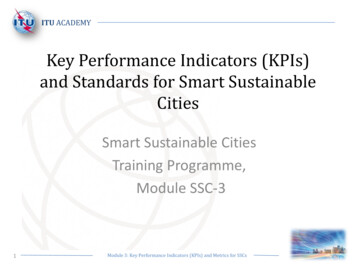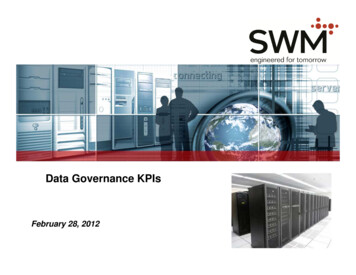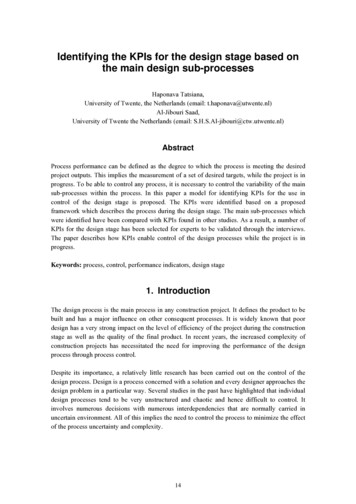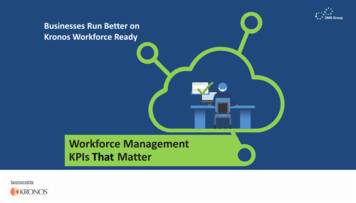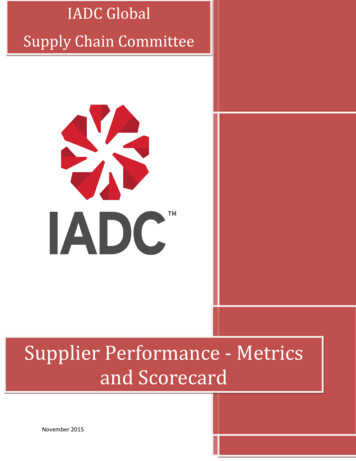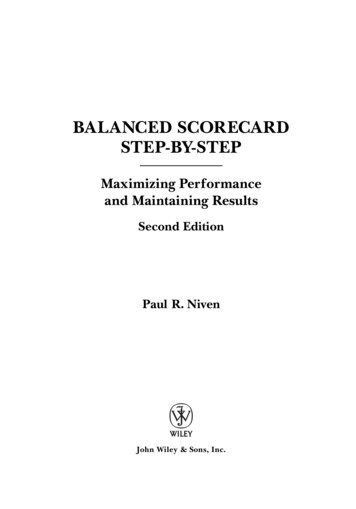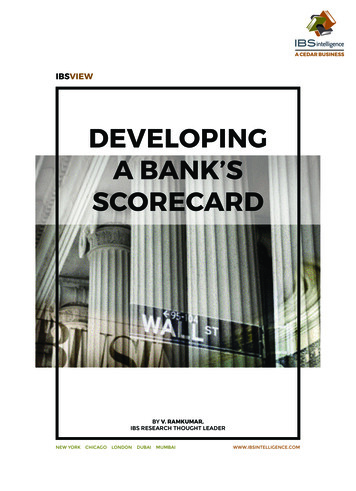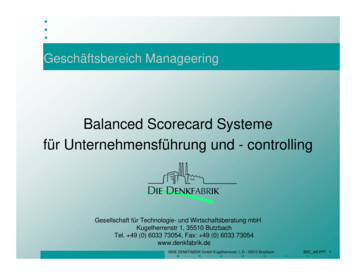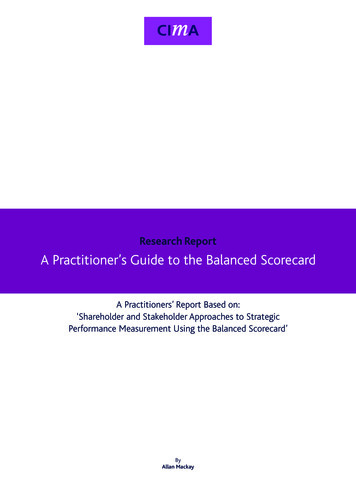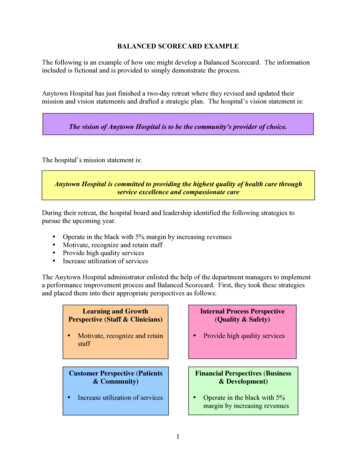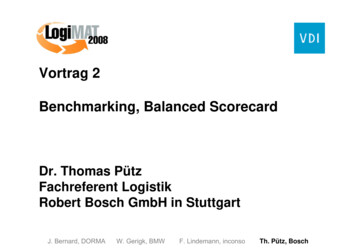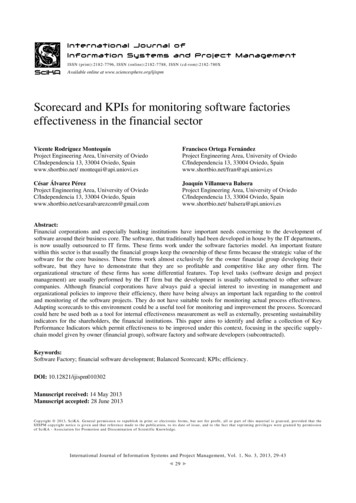
Transcription
ISSN (print):2182-7796, ISSN (online):2182-7788, ISSN (cd-ro m):2182-780XAvailable online at www.sciencesphere.org/ijispmScorecard and KPIs for monitoring software factorieseffectiveness in the financial sectorVicente Rodríguez MontequínProject Engineering Area, University of OviedoC/Independencia 13, 33004 Oviedo, Spainwww.shortbio.net/ montequi@api.uniovi.esFrancisco Ortega FernándezProject Engineering Area, University of OviedoC/Independencia 13, 33004 Oviedo, Spainwww.shortbio.net/fran@api.uniovi.esCésar Álvarez PérezProject Engineering Area, University of OviedoC/Independencia 13, 33004 Oviedo, quín Villanueva BalseraProject Engineering Area, University of OviedoC/Independencia 13, 33004 Oviedo, Spainwww.shortbio.net/ balsera@api.uniovi.esAbstract:Financial corporations and especially banking institutions have important needs concerning to the development ofsoftware around their business core. The software, that traditionally had been developed in house by the IT departments,is now usually outsourced to IT firms. These firms work under the software factories model. An important featurewithin this sector is that usually the financial groups keep the ownership of these firms because the strategic value of thesoftware for the core business. These firms work almost exclusively for the owner financial group developing theirsoftware, but they have to demonstrate that they are so profitable and competitive like any other firm. Theorganizational structure of these firms has some differential features. Top level tasks (software design and projectmanagement) are usually performed by the IT firm but the development is usually subcontracted to other softwarecompanies. Although financial corporations have always paid a special interest to investing in management andorganizational policies to improve their efficiency, there have being always an important lack regarding to the controland monitoring of the software projects. They do not have suitable tools for monitoring actual process effectiveness.Adapting scorecards to this environment could be a useful tool for monitoring and improvement the process. Scorecardcould here be used both as a tool for internal effectiveness measurement as well as externally, presenting sustainabilityindicators for the shareholders, the financial institutions. This paper aims to identify and define a collection of KeyPerformance Indicators which permit effectiveness to be improved under this context, focusing in the specific supplychain model given by owner (financial group), software factory and software developers (subcontracted).Keywords:Software Factory; financial software development; Balanced Scorecard; KPIs; efficiency.DOI: 10.12821/ijispm010302Manuscript received: 14 May 2013Manuscript accepted: 28 June 2013Copyr ight 2013, SciKA. General per missio n t o republish in pr int or elect ronic forms, but not for profit , all or part of t his mat er ial is gran t ed, provided t hat t heIJISPM copyr ight not ice is given and t hat reference made t o t he publicat ion, t o it s dat e of issue, and t o t he fact t hat repr int ing pr ivileges were grant ed by per miss io nof SciKA - Associat io n for Promot ion and Disseminat io n of Scient ific Knowledge.International Journal of Information Systems and Project Management, Vol. 1, No. 3, 2013, 29-43 29
Scorecard and KPIs for monitoring software factories effectiveness in the financial sector1. IntroductionFinancial corporations and especially banking institutions require a great deal of software development. Thedevelopment of business applications represents more than 50% of the IT budget [1]. Traditionally, banking is thesector which not only requires the highest level of software development, but which also has a higher tendency toexternalize the development of projects of that type. They had large IT departments where the business software wasdeveloped, but following the modern managerial trends, now it is outsourced to external firms. Most of these firms werecreated by the financial groups in the beginning of the two thousand and usually they have kept the ownership andcontrol because the extreme importance of the software for the core business. So these firms work also exclusively forthe matrix financial group, but they have to demonstrate to be more competitive than other firms. In addition, financialinstitutions have pushed these firms to reduce cost, which has obliged them to search for new productive models inorder to remain competitive. Most of them have followed the “software factory” model. A software factory appliesmanufacturing techniques and principles to software development to mimic the benefits of traditional manufacturing.Financial sector have always paid a special interest to investing in management and organizational policies to improvetheir efficiency. Finance and banking are one of the sectors in which more effort has been applied for measuringproductivity in all of their departments. However, their weakest point is still the measurement and monitoring of theproductivity of the development of the software projects that support its main core activity. One of the reasons why thisproductivity is not being suitable analyzed is due to the software nature of intangible. This lack has been alsotransferred to the software firms. The firms pay according to the estimated effort it takes to be produced and notaccording to the quantity and quality of the actual software produced. This model eventually involves a further increasein costs for the project.Usually these firms perform the top level design and control of the projects, but the development is usuallysubcontracted to other companies specialized in software development. This structure appears as a natural reaction fromthe financial groups for keeping the control of their software. Subcontracting the development is the usual strategy forminimizing costs. Nowadays, the financial groups are pushing their software firms to cut cost, who are also pressingtheir subcontractors to reduce costs. As reaction of this context, the subcontractors have explored several strategies forcutting costs, some of them lying in a loss of quality. For instance, they have created offshore software factories. Thecreation of these software factories is justified as a way of increase productivity and efficiency. However, the realitycould not be more different. Realistically, the truth of the matter is that there are evidences which tell us that there is areduction in costs by employing a cheaper workforce but with a loss of quality in most cases. These facts remark theneed of controlling and monitoring systems from the side of the contractor, the software factories of the financialgroups.The explored way in this work for improving this process is based on scorecard approach. Key Performance Indicators(KPIs) accommodated in scorecards is an usual tool within the strategic management, but is rarely used effectively inthe field of software projects, which are more commonly evaluated by productivity assessment metrics linked to thegeneration of code as the "number of lines of code" or "function points" [2]. This work aims to identify and define acollection of Key Performance Indicators which permit effectiveness to be measured in these types of organizations inthis supply-chain context. The different key indicators are conveniently set in a specific scorecard that allows decisionmaking associated with top level project portfolio management.The context where we study was carried out is introduced in the background section. Special consideration is doneregarding to the structure of these kind of Software Factories and their features. The basis of the Balanced Scorecard isalso introduced. Then the suggested model is described in section 3, grouping the identified KPIs in six perspectives:financial; customer; human resources and growth; productivity; software quality-quality in use; software qualityproduct quality. Each perspective is summarized in a table including the KPI formulation. Finally conclusions andfuture work is described in the final section.International Journal of Information Systems and Project Management, Vol. 1, No. 3, 2013, 29-43 30
Scorecard and KPIs for monitoring software factories effectiveness in the financial sector2. BackgroundThe Software Factory is generally defined as the workplace where software is developed using techniques andprinciples associated with traditional industrial production. The Software Industry needs to become similar to theindustrialized software manufacturing process in order that it is able to provide everything the market expects todayrelated to efficiency, fast delivery and quality in all industrial products. Such transformation requires significantchanges in the industry, but the sooner they are carried out, them the actors will gain larger competitive advantages [3].Software engineering seems not to have made use of the latest technological advanced in software production [4].Although the term Software factory was first introduced in 1968, it is due to the recent social, economic andtechnological circumstances that the term Software factory becomes notorious again among the software sector [5].Authors like Greenfield et al. [6], from Microsoft, use the concept of the Software factory as a structured collection ofrelated software assets that assists in producing computer software applications or software components according tospecific, externally-defined end-user requirements through an assembly process. The aim of a Software factory is theimprovement of productivity and quality, scale production and the maintenance of software development control [7].The Software Industry is turning into a new business model, where the different centers work together to achieveobjectives and developments.The term software factory had already been used by 1975 when Harvey Bratman and Terry Court, from the SystemDevelopment Corporation, described in one of their papers the challenge of developing an integrated set of softwaredevelopment tools to support a disciplined and repetitive approach to software development. This effort was a part of alarge program to increase software reliability and control software production cost using standard engineeringtechniques. This study, which attempted in part to correlate program productivity and experience, identified the lack ofa methodical and well founded body of knowledge on the software development process. The most significant problemsthat contributed to this shortcoming were: Lack of discipline and repetitiveness; Lack of development visibility; Lack of design and verification tools; Lack of software reusability.Despite the introduction and use of new techniques and methodologies about software development, the fact is that formore than 30 years after the introduction of software factory concept, and even today, many of the initial issues andother problems associated with them (systematic reuse, assembly development, model-driven development and processframeworks) cannot been resolved yet [6].Nowadays, there is a great deal of pressure on software delivery organizations to produce more software at a faster ratein the context of extreme cost pressure and growing globalization of the software delivery organization. The concept ofa software factory is beginning to emerge as one way to address these challenges. The principles of software factory arenecessary for enterprise software delivery to propose faster deliveries, reduce cost and increase software quality [8].Many companies have experienced a great deal of change over the past few years due to evolution of the businessenvironment, financial upheavals, societal changes and technical advancement. The key to addressing these changes hasbeen analysis of the core business processes to see how they can be refined and optimized, followed by a restructure ofthose business processes to better meet the new context.At the same time, IT groups have been forced to lower operating costs across the organization. The direct implication isthat they must not only minimize waste and inefficiency, but increase productivity and relevance to the businesses theyserve.International Journal of Information Systems and Project Management, Vol. 1, No. 3, 2013, 29-43 31
Scorecard and KPIs for monitoring software factories effectiveness in the financial sectorThis combination of business process restructuring and close focus on delivery efficiency have been seen in manybusiness domains, and has resulted in techniques such as lean manufacturing, supply-chain management, and productline engineering. The application of these ideas in software delivery is what we refer to here as a software factoryapproach to enterprise software delivery [9],[10].Although there are different development standards to measure in-house development, there is little standardization inevaluating supply-chains and software factories. Standard approaches such as function point analysis and defect densitycan be applied, but in practice they appear inadequate. With more complex supply-chain delivery models becomingmore common, we need metrics that help us address different questions: Which software factory is more productive and efficient? Which software factory experiences a delay when delivering their products? What is the quality of the software delivered?These and other many other measures need to be defined and an automatic mechanism to collect these metrics must beimplemented to help compare results across external providers in real time [8].This paper works about the presented questions, and its objective is to develop a scorecard and a set of suitableindicators to provide managers answers about the productivity and efficiency in a software factory oriented towardsfinancial sector.2.1 The software factory architecture, according the software factory processesThe main features of software factories for financial software development are usually the next: They work almost exclusively for the owner group; These usually have a greater demand of requests; The software development process is usually subcontracted to several software companies. However, due tostrategic reasons, this does not apply to top level processes such as functional specifications and projectmanagement; Usually the payments to subcontractors are made according to the number of hours budgeted, and not by thenumber of hours actually performed.The usual organizational structure for software factory orientated financial software should not differ substantially fromwhat is presented below, which include the following processes: Demand Management, which aims to collect top level user requirements and establish methods for prioritizingdemands; Functional Analysis, which transforms the identified top level user requirements into functional requirements; Technical Analysis, which is responsible for the technical details of the functional specifications which must beimplemented; Development, which performs the development, construction and assembling of the requested requirements; Testing, which has to validate everything that has been implemented; Production, which performs the customer deployment; Quality, which assesses the global system quality.In the proposed schema, the development process is subcontracted to several software development firms. On the otherhand, the rest of the processes are under the software factory control. Fig. 1 illustrates the usual process followed in thisscheme of operation, which is similar as [4].International Journal of Information Systems and Project Management, Vol. 1, No. 3, 2013, 29-43 32
Scorecard and KPIs for monitoring software factories effectiveness in the financial sectorFig. 1. Map of processes of model for software factory oriented financial sectorThe system described involves several different levels of control to evaluate the efficiency. The measuring productivityof the development process is based on metrics as function points, number of defects, etc. All of these methods havebeen widely studied in the literature, though it is the work of Fenton [11] that most of these practices are based on.These controls are made into development software areas by the outsourced firms.The proposed scorecard presented here does not incorporate this level, since within the presented context it is themeasurement in the top level that is much more interesting. At this level we need to focus on the overall projectportfolio and productivity ratios of the whole system. Some of the questions that the scorecard must find and provideanswers for are as follows: What is the software factory Performance? What are the cost and time deviations compared to the estimations? What is the employees’ productivity? What is the level of customer satisfaction? What is the value provided by developers and the rest of the human capital?International Journal of Information Systems and Project Management, Vol. 1, No. 3, 2013, 29-43 33
Scorecard and KPIs for monitoring software factories effectiveness in the financial sector2.2 Using scorecard for the efficiency measurementOrganizations have used systems consisting of a mix of financial and non-financial measures to track progress for quitesome time. In the mid-1990s, a new method emerged. In the new method, measures are selected based on a set of“strategic objectives” plotted on a “strategic linkage model” or “strategy map”. With this new approach, the strategicobjectives are distributed across the four measurement perspectives to form a visual presentation of strategy andmeasures. This method was named “Balanced Scorecard”. The Balanced Scorecard is a strategy performancemanagement tool - a semi-standard structured report, supported by design methods and automation tools, which can beused by managers to keep track of the execution of activities by the staff within their control and to monitor theconsequences arising from these actions. The Harvard Business Review, in its 75th Anniversary issue, cites theBalanced Scorecard as being one of the 15 most important management concepts to have been introduced via articles inthe magazine. Since its introduction in 1992, the Balanced Scorecard has featured in a wealth of academic andpractitioner papers, and has been the subject of several bestselling books.The Balanced Scorecard was originally proposed as an approach to performance measurement that combined traditionalfinancial measures with non-financial measures to provide managers with richer and more relevant information aboutorganizational performance, particularly with regard to key strategic goals [12].By encouraging managers to focus on a limited number of measures drawn from four “perspectives”, the originalBalanced Scorecard aimed to encourage clarity and utility. Over time Balanced Scorecard has developed to form thecenter-piece of a strategic communication and performance measurement framework that helps management teamsarticulate, communicate and monitor the implementation of strategy using a system interlinked with the long-termdestination of the organization. More recent insights suggest that a successful Balanced Scorecard implementation willrequire adjustments to be made to other management processes used by the enterprise. Only in so doing will theBalanced Scorecard be able to become a central part of a “strategic management framework” [13].Some of the benefits of using the Balanced Scorecard are: It improves the bottom line by reducing process cost and improving productivity and mission effectiveness; Measurement of process efficiency provides a rational basis for selecting what business process improvements tomake first; It allows managers to identify best practices in an organization and expand their usage elsewhere; The visibility provided by a measurement system supports better and faster b
The term software factory had already been used by 1975 when Harvey Bratman and Terry Court, from the System Development Corporation, described in one of their papers the challenge of developing an integrated set of software development tools to support a disciplined and repetitive appr
